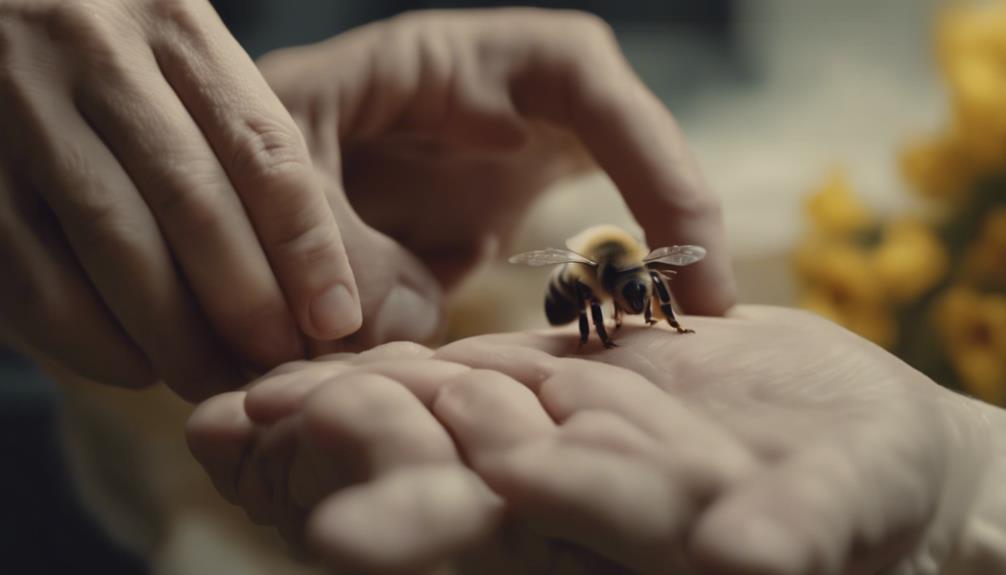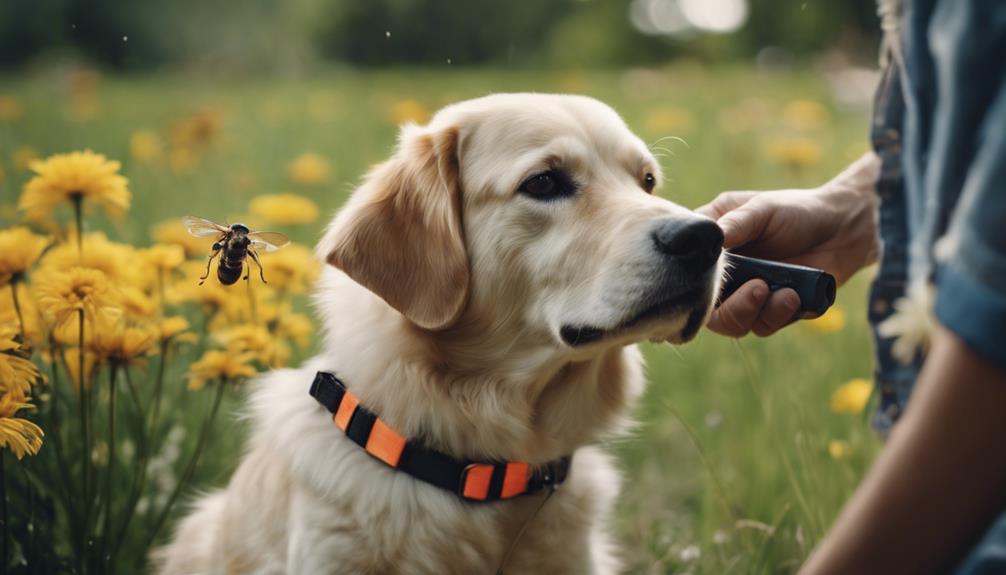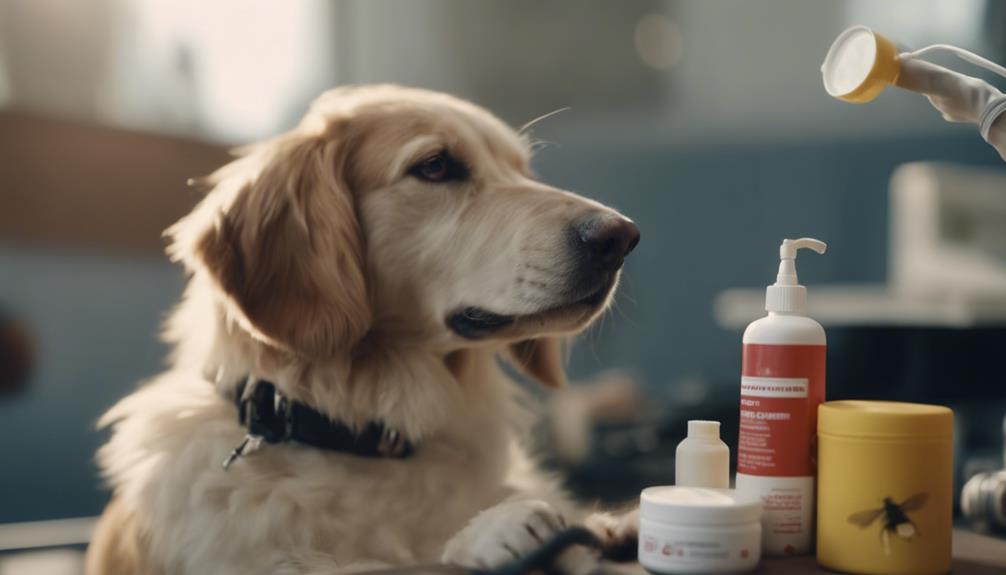Understanding the appropriate steps to aid your dog in recovering from bee stings and insect bites is crucial for pet owners.
From recognizing the signs of distress to administering immediate care, each action taken can significantly impact your furry companion's well-being.
By delving into the details of symptom identification, treatment options, and preventative measures, this discussion aims to equip you with the knowledge needed to navigate such situations effectively.
Stay tuned to discover the essential strategies that can make a difference in your dog's healing process and overall safety.
Key Takeaways
- Remove stinger promptly and apply cold compress or baking soda paste.
- Monitor for allergic reactions and consider antihistamines like Benadryl.
- Seek vet help for severe symptoms; use preventatives to avoid future incidents.
- Regularly groom for bugs, use preventatives, and maintain bug-free surroundings.
Identifying Symptoms of Bee Stings & Bites
Recognizing the signs of bee stings and insect bites in dogs is crucial for prompt and effective treatment. Symptoms may include swelling, hives, licking the affected area, whining, and drooling.
When observing these signs, it is important to act swiftly to alleviate discomfort and prevent potential complications. Immediate actions such as removing the stinger, monitoring for severe allergic reactions, and applying remedies like baking soda paste or cold compresses can aid in soothing the affected area.
Additionally, considering an oatmeal bath for multiple bites and using a head cone to prevent further irritation are practical steps to manage the situation.
Being vigilant in identifying these symptoms enables pet owners to provide timely care and support for their furry companions.
Immediate Actions After Insect Bites
When a dog experiences an insect bite, prompt and appropriate actions can help alleviate discomfort and prevent potential complications. One should start by removing the stinger if visible, followed by monitoring for severe allergic reactions. Applying a baking soda paste or cold compress can help reduce swelling and itchiness. In cases of multiple bites, considering an oatmeal bath may provide additional relief. Using a head cone can prevent the dog from further irritating the affected area. Below is a table summarizing immediate actions after insect bites:
| Immediate Actions | Description |
|---|---|
| Remove the stinger | Use tweezers to gently pull it out. |
| Monitor for allergic reactions | Watch for signs like difficulty breathing. |
Treating Bee Stings & Insect Bites

In addressing bee stings and insect bites on dogs, prompt and appropriate treatment is essential to alleviate discomfort and prevent potential complications.
For bee stings, it is crucial to remove the stinger promptly to prevent further venom injection. Applying a baking soda paste or a cold compress can help reduce swelling and soothe the affected area. Consider administering antihistamines like Benadryl to manage allergic reactions.
In the case of fire ant bites, treatments such as baking soda paste, cold compresses, or Benadryl can be beneficial. Monitoring for severe symptoms and seeking veterinary assistance when necessary is vital to ensure the well-being of the dog.
Additionally, using preventatives for fleas, ticks, and mosquitoes can help minimize the risk of future insect bites.
Preventing Future Bug Bites
To minimize the risk of future bug bites on dogs, proactive measures can be implemented to create a safer environment for your pet. Here are some tips to help prevent bug bites:
- Regularly groom your dog to check for any signs of bugs or bites.
- Use flea and tick preventatives recommended by your veterinarian.
- Keep your yard and the areas where your dog plays clean and free of standing water.
- Avoid walking your dog in tall grass or wooded areas where bugs are more prevalent.
- Consider using bug repellents specifically formulated for dogs when venturing into areas with a high bug population.
Monitoring Dogs Outdoors

Regularly observing your dog while they are outdoors is crucial for ensuring their safety and well-being. When your dog is outside, keep an eye on their behavior and interactions with the environment. Look out for any signs of discomfort, such as excessive scratching, pawing at certain areas, or sudden changes in activity levels.
Monitoring your dog can help you quickly identify if they have been stung or bitten by an insect, allowing you to take prompt action. Additionally, being aware of your surroundings can help you steer your dog away from potential risks like beehives, wasp nests, or ant hills.
Using Antihistamines for Relief
When managing bee stings and insect bites in dogs, incorporating antihistamines can provide relief from allergic reactions and alleviate symptoms. Antihistamines work by blocking the effects of histamine, a compound released during an allergic reaction.
Here are some important points to consider when using antihistamines for your dog:
- Consult your veterinarian for the appropriate antihistamine dosage for your dog's size.
- Common antihistamines for dogs include Benadryl (diphenhydramine) and Zyrtec (cetirizine).
- Ensure the antihistamine does not contain additional ingredients that could be harmful to dogs.
- Watch for side effects such as drowsiness or gastrointestinal upset.
- If your dog shows no improvement after administering antihistamines, seek veterinary assistance promptly.
Managing Allergic Reactions

Effective management of allergic reactions in dogs following bee stings and insect bites is crucial for ensuring their prompt recovery and well-being. It is essential to be prepared to handle any potential allergic reactions that may occur in your furry friend. Here is a table outlining key steps to manage allergic reactions in dogs:
| Allergic Reaction Management for Dogs | ||
|---|---|---|
| 1. Observe Symptoms | 2. Administer Antihistamines | 3. Seek Veterinary Assistance |
| Watch for swelling, hives, or difficulty breathing. | Provide vet-approved antihistamines like Benadryl. | Contact a vet immediately for severe reactions. |
| Monitor for excessive itching or licking. | Follow proper dosages as per your vet's instructions. | Vet intervention may be necessary for severe cases. |
| Keep your dog calm and comfortable. | Be aware of potential side effects and act accordingly. | Professional help ensures appropriate treatment. |
Pest-Proofing Your Home
After effectively managing allergic reactions in dogs following bee stings and insect bites, ensuring a pest-proof home environment becomes paramount to prevent future incidents and safeguard your pet's well-being.
- Seal cracks and crevices where pests can enter
- Keep food items securely stored in airtight containers
- Regularly clean up crumbs and spills to avoid attracting insects
- Dispose of garbage promptly in sealed bins
- Trim bushes and trees around the house to eliminate potential pest hiding spots
Seeking Veterinary Assistance

Seeking veterinary assistance is crucial for dogs experiencing severe symptoms from bee stings or insect bites, as prompt professional evaluation and treatment can help ensure a speedy recovery and prevent potential complications. When deciding whether to seek veterinary help, consider the severity of symptoms and your pet's overall health. Here is a table outlining some signs that indicate the need for immediate veterinary attention:
| Symptom | Description | Action |
|---|---|---|
| Difficulty breathing | Wheezing, gasping for air | Seek immediate veterinary assistance |
| Swelling | Rapid and extensive swelling | Consult your veterinarian promptly |
| Vomiting | Persistent vomiting after a sting/bite | Contact your vet for guidance |
| Collapse | Sudden weakness or collapse | Get urgent veterinary help |
Using Vet-Recommended Preventatives
To safeguard your dog from bee stings and insect bites, it is imperative to utilize preventatives recommended by veterinary professionals. These preventatives not only help in preventing potential stings and bites but also contribute to your dog's overall well-being. Here are five vet-recommended preventatives to consider:
- Flea and tick preventatives
- Mosquito repellents
- Topical treatments
- Oral medications
- Collars with insect-repelling properties
Conclusion
In conclusion, by promptly identifying symptoms, taking immediate actions, and implementing proper treatment and preventative measures, pet owners can effectively help their dogs heal from bee stings and insect bites.
Monitoring dogs outdoors, managing allergic reactions, pest-proofing homes, seeking veterinary assistance when needed, and using vet-recommended preventatives are crucial steps in ensuring the well-being and safety of canine companions.
Adhering to these strategies can contribute to a healthier and happier life for beloved pets.




